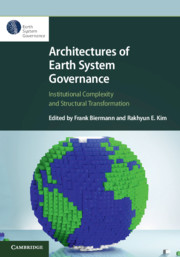Book contents
- Architectures of Earth System Governance
- Series page
- Architectures of Earth System Governance
- Copyright page
- Contents
- Contributors
- Acknowledgements
- 1 Architectures of Earth System Governance
- Part I The Building Blocks
- 2 Intergovernmental Institutions
- 3 International Bureaucracies
- 4 Transnational Institutions and Networks
- 5 Institutional Architectures for Areas beyond National Jurisdiction
- Part II Core Structural Features
- Part III Policy Responses
- Part IV Future Directions
- Glossary
- Index
- References
4 - Transnational Institutions and Networks
from Part I - The Building Blocks
Published online by Cambridge University Press: 17 April 2020
- Architectures of Earth System Governance
- Series page
- Architectures of Earth System Governance
- Copyright page
- Contents
- Contributors
- Acknowledgements
- 1 Architectures of Earth System Governance
- Part I The Building Blocks
- 2 Intergovernmental Institutions
- 3 International Bureaucracies
- 4 Transnational Institutions and Networks
- 5 Institutional Architectures for Areas beyond National Jurisdiction
- Part II Core Structural Features
- Part III Policy Responses
- Part IV Future Directions
- Glossary
- Index
- References
Summary
This chapter reviews the literature on transnational institutions and networks in earth system governance research over the past decade. The chapter focuses in particular on the issues of emergence, effectiveness and legitimacy of transnational governance and outlines key debates and controversies surrounding the shifting authority between public and private actors. The chapter also identifies major research lines and open questions and provides an outlook towards the most promising directions in future research. The review is based on 215 articles identified in the Web of Science (co)authored by fellows of the Earth System Governance Project from 2008 to 2018.
- Type
- Chapter
- Information
- Architectures of Earth System GovernanceInstitutional Complexity and Structural Transformation, pp. 75 - 96Publisher: Cambridge University PressPrint publication year: 2020
References
- 7
- Cited by



